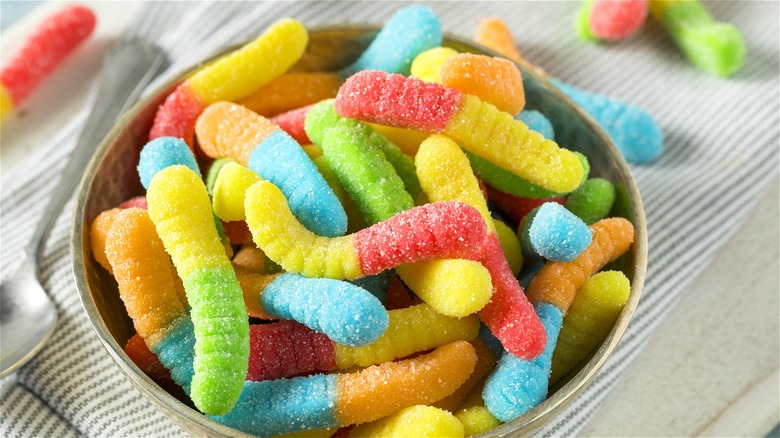The Invention Of Gummy Worms Is Not Nearly As Far Back As We Thought
Choosing a favorite candy is a difficult feat nowadays, considering there are hundreds of options to choose from at your neighborhood confectionary. Besides regularly consuming everyone's chocolatey favorites like Snickers and M&M's, you may be the type of person who craves sour, chewy, or fruity candies like classic gummy bears or Sour Patch Kids. Even if you consider yourself a gummy connoisseur, you may not have known that the most popular candy that debuted the year you were born could very well be the elusive gummy worm.
The first gummy worms were introduced as Gummi Squiggles by the European Trolli brand in the early 1980s. This may seem odd to you, especially if you're already in the know about the history behind jelly beans and gummy bears. These varieties had already been popular products for quite some time when the decade of hair bands, Blockbuster, and convenient snacking rolled around.
Fast-forward to modern times, and you can now find gummy cherries, gummy sharks, and even mini gummy pizzas, hot dogs, and burgers. So, why were gummy worms (or Gummi Squiggles, in this case) marketed specifically to Americans in the later part of the 20th century?
How the gummy worm caught America's attention
In 2023, not only can you buy a number of different gummy worms depending on which candy shop you visit, but you can also find recipes for homemade gummy worms. And we have candy developer Hans Riegel Bonn of Germany to thank for Haribo's colorful gummy bears. The original purpose behind making gummy candy into fun, life-like shapes was to give this textured candy its persona. But why were gummy worms the designated shape of choice used to attract the attention of American citizens?
By the time the 1960s and 1970s rolled around, companies like Haribo were releasing gummy candies in fun, unexpected shapes, such as lions and gorillas. But worms weren't exactly synonymous with zoo animals. The idea of using worms to appeal to candy lovers comes from America's desire to experience foods or confections that are a little more bizarre than mainstream varieties but still have a fruity, sweet flavor. (Who doesn't have a memory of secretly biting into a gummy worm as a kid thinking of how slightly gross, daring, and delicious it was?)
Trolli was onto something when the business decided to impress America's candy lovers with this unexpected treat. Fast-forward to the 21st century, and apart from the nation's increased adoration for oddly shaped gummies, Trolli has also expanded its marketing campaign in the last few years to capitalize on Americans' hidden love for all things bizarre.
Unconventional candies have taken America by storm
Trolli continues to increase its advertising game to further sensationalize the brand's product line. Confectionary News notes that in 2019 Trolli, leveled up its marketing, focusing more on its outlandish troll mascot and the character's odd experiences searching for happiness through somewhat scary or daring circumstances. This appealed directly to the nation's love for foods that seem slightly out of bounds.
While Trolli was the first company to trademark the popular gummy worm by combining two fruity flavors, such as lemon and cherry, into a single piece of candy, the popular gummy brand now has more than 20 chewy candy products available in the U.S., including Sour Brite Eggs and Sour Brite Crawlers.
America can't seem to get enough of brightly colored chewy candy these days, either. According to the National Confectioners Association, in 2021, chewy sour candy sales were up almost 25% compared to the previous year. Nowadays, you can practically find any gummy candy to suit your desires — even gummy centipedes are a real thing. Before you pop another classic gummy worm in your mouth, take an extra moment to appreciate this somewhat recent invention. This slightly off-putting yet exciting treat continues to win the hearts (and mouths) of Americans.


